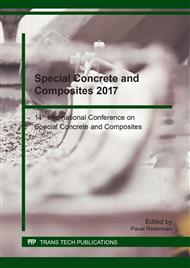[1]
P. Reiterman, M. Jogl, V. Baumelt, J. Seifrt, Development and Mix Design of HPC and UHPFRC, Adv. Mater. Res. 982 (2014) 130-135.
DOI: 10.4028/www.scientific.net/amr.982.130
Google Scholar
[2]
W. Kubissa, T. Simon, R. Jaskulski, P. Reiterman, M. Supera, Ecological High Performance Concrete, Procedia Eng. 172 (2017) 595–603.
DOI: 10.1016/j.proeng.2017.02.186
Google Scholar
[3]
R. Chudoba, M. Konrad, M. Vorechovsky, A. Roye, Numerical and experimental study of imperfections in the yarn and its bond to cementitious matrix, Spec. Publ., vol. 244, p.39–56, (2007).
DOI: 10.14359/18751
Google Scholar
[4]
R. Chudoba, M. Vořechovský, M. Konrad, Stochastic modeling of multi-filament yarns. I. Random properties within the cross-section and size effect, Int. J. Solids Struct. 43(2006) 413–434.
DOI: 10.1016/j.ijsolstr.2005.06.063
Google Scholar
[5]
J. Hegger, N. Will, O. Bruckermann, S. Voss, Load–bearing behaviour and simulation of textile reinforced concrete, Mater. Struct. 39/8 (2006) 765–776.
DOI: 10.1617/s11527-005-9039-y
Google Scholar
[6]
W. Graf, A. Hoffmann, B. Möller, J. -U. Sickert, F. Steinigen, Analysis of textile-reinforced concrete structures under consideration of non-traditional uncertainty models, Eng. Struct. 29/12 (2007) 3420–3431.
DOI: 10.1016/j.engstruct.2007.08.013
Google Scholar
[7]
B. Möller, W. Graf, A. Hoffmann, F. Steinigen, Numerical simulation of RC structures with textile reinforcement, Comput. Struct. 83/19 (2005) 1659–1688.
DOI: 10.1016/j.compstruc.2004.11.024
Google Scholar
[8]
J. Hartig, U. Häußler-Combe, and K. Schicktanz, Influence of bond properties on the tensile behaviour of Textile Reinforced Concrete, Cem. Concr. Compos. 30/10 (2008) 898–906.
DOI: 10.1016/j.cemconcomp.2008.08.004
Google Scholar
[9]
T. Vlach, A. Chira, L. Laiblová, C. Fiala, M. Novotná, P. Hájek, Numerical Simulation of Cohesion Influence of Textile Reinforcement on Bending Performance of Plates Prepared from High Performance Concrete (HPC), Adv. Mater. Res. 1106 (2015).
DOI: 10.4028/www.scientific.net/amr.1106.69
Google Scholar
[10]
T. Vlach, L. Laiblová, A. Chira, M. Novotná, C. Fiala, M. Ženíšek, P. Hájek, Comparison of Different Methods for Determination of Modulus of Elasticity of Composite Reinforcement Produced from Roving, Adv. Mater. Res. 1054 (2014) 104-109.
DOI: 10.4028/www.scientific.net/amr.1054.104
Google Scholar
[11]
V. Cervenka, J. Cervenka, and R. Pukl, ATENA — A tool for engineering analysis of fracture in concrete, Sadhana 27/4 (2002) 485–492.
DOI: 10.1007/bf02706996
Google Scholar
[12]
T. Vlach, M. Novotná, C. Fiala, L. Laiblová, and P. Hájek, Cohesion of Composite Reinforcement Produced from Rovings with High Performance Concrete, Appl. Mech. Mater., vol. 732, p.397–402, (2015).
DOI: 10.4028/www.scientific.net/amm.732.397
Google Scholar


